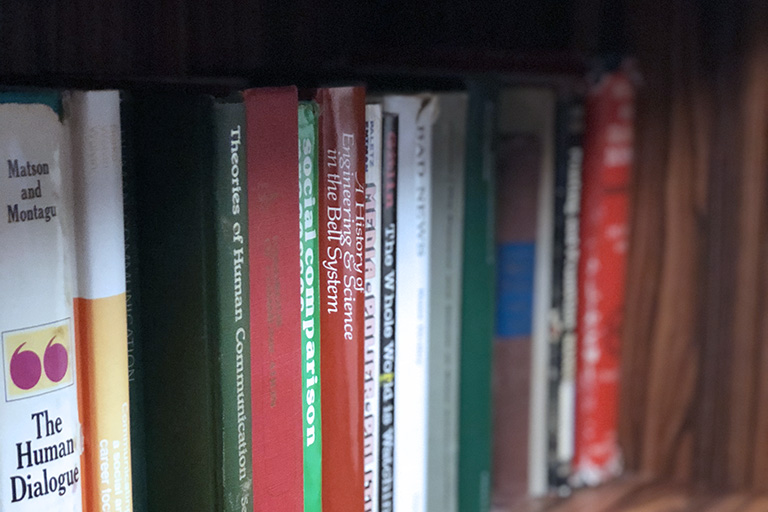Boster, F.J. (2006). Communication as social influence. In G.J. Shepherd, J. St. John, & T. Striphas (Eds.), Communication as . . . Perspectives on theory (pp. 180-186). Thousand Oaks, CA: Sage.
Boster, F.J., Meyer, G.S., Roberto, A.J., Inge, C., & Strom, R. (2006). Some effects of video streaming on educational achievement. Communication Education, 55, 46-62.
Bresnahan, M.J., Kagawa, N., Song, J.A., & Inoue, Y. (2006). Players and whiners: Responses to the depiction of gender In Japanese anime. Asian Journal of Communication, 16, 2, 207-217.
Dearing, J.W. (2006), “Communication as Diffusion,” in Gregory J. Shepherd, Jeffrey St. John, and Ted Striphas (Eds.), Communication As ... Perspectives on Theory. Thousand Oaks, CA: Sage, 174-179.
Desouza, R., & Sherry, J.L. (2006). Portrayals of romantic conflict on adolescent television. Media Report to Women, 34(1).
Donohue, W.A. (2006). Managing interpersonal conflict: The mediation promise. In John Oetzel and Stella Ting-Toomey (Ed’s.), The Sage handbook of conflict communication (pp. 211-234). Thousand Oaks, CA: Sage.
Donohue, W.A. & Taylor, P.J. (2006) Lessons from hostage negotiation. In Andrea Kupfer Schneider and Christopher Honeyman (Ed’s.), The negotiator's fieldbook. New York: The American Bar Association Section on Dispute Resolution.
Lapinski, M.K. (2006). Starving for Perfect.com: A theoretically-based content analysis of pro-eating disorder websites. Health Communication, 20(3), 243-253. (2011 Impact Factor: .971; 5 Year Impact Factor: 1.763)
Levine, T.R., Hullett, C.R., Turner, M.M., & Lapinski, M.K. (2006). The Desirability of Using Confirmatory Factor Analysis on Published Scales. Communication Research Reports, 23(4), 309-314. (2011 Impact factor: 2.014)
Martell, D., Atkin, C.K., Hembroff, L.A., Smith, S.W., Baumer, A.J., & Greenamayer, J. (2006) College students and “celebration drinking.” Social Norms Review, 1, 10-17.
Reisdorff, E.J., Hughes, M.J., Casteneda, C., Carlson, D.J., Donohue, W.A., Fediuk, T.A., 7 Hughes, W.P. (2006). Developing a valid evaluation for interpersonal and communication skills. Academic Emergency Medicine, 13, 1056-1061.
Rottinghaus, B. & Bergan, D.E. (2006). New data and new directions: Interbranch lobbying in the George H. W. Bush White House. Congress and the Presidency, 33(1), 75-94.
Senokozlieva, M., Fischer, O., Bente, G., & Krämer, N. (2006). Of Frames and Cultures - A Cross-Cultural Comparison of TV Newscasts. Zeitschrift für Medienpsychologie, 18(4), 160-173.
Sherry, J.L. (2006). Violent video games and aggression: Why can’t we find effects? In R. Preiss, B. Gayle, N. Burrell, M. Allen, & J. Bryant (Eds.). Mass Media Effects Research: Advances Through Meta-Analysis. Mahwah, NJ: Erlbaum.
Sherry, J.L. (2006). Would the great and mighty Oz play Doom? A look behind the curtain of violent video game research. In P. Messaris & L. Humphreys (Eds.). Digital Media: Transformations in Human Communication. New York, Peter Lang.
Sherry, J.L., Lucas, K., Greenberg, B., & Lachlan, K. (2006). Video game uses and gratifications as predictors of use and game preference. In P. Vorderer & J. Bryant (Eds.). Playing Computer Games: Motives, Responses, and Consequences. Mahwah, NJ: Erlbaum.
Sherry, J.L., & Pacheco, A. (2006). Matching computer game genres to educational outcomes. Electronic Journal of Communication.
Silk, K.J., Bigsby, E., Volkman, J., Kingsley, C., Atkin, C., Ferrara, M., & Goins, L.A. (2006). Formative research on adolescent and adult risk factors for breast cancer. Social Science and Medicine, 63, 3124-3136. (ISI: 3.48)
Skalski, P., Lange, R., & Tamborini, R. (2006). Mapping the way to fun: The effect of video game interfaces on presence and enjoyment. In Bracken, C. C. & Lombard, M. (Eds.) The Ninth Annual International Workshop on Presence Proceedings (pp. 65-66). Cleveland, OH: Cleveland State University.
Smith, S.W., Atkin, C.K., Martell, D., Allen, R., & Hembroff, L. (2006). A social judgment theory approach to conducting formative research in a social norms campaign. Communication Theory, 16, 141-152. Doi:10.1111/j.1468-2885.2006.00009.x Also reprinted in (2010) G.L. Kreps (Ed), Health communication: Health communication and health promotion (Volume 2, pp.261-274). London: Sage.
Smith, S.W., Atkin, C.K., & Roznoswki, J.A. (2006). Are “drink responsibly” alcohol campaigns strategically ambiguous? Health Communication, 20, 1-11. Doi:10.1207/s15327027hc2001_1
Smith, S.W., Smith, S.L., Pieper, K.M., Yoo, J.H, Ferris, A., Downs, E., & Bowden, B. (2006). Altruism on American television: Examining the amount of, and context surrounding, acts of helping and sharing. Journal of Communication, 56, 707-727. Doi:10.1111/j.1460-2466.2006.00316.x
Steinke, J., Lapinski, M,K., Zietsman-Thomas, A., Crocker, N., Williams, Y., Higdon, S., & Kuchibhotla, S. (2006) Assessing media influences on girls’ perceptions of science, engineering and technology. Journal of Women and Minorities in Science and Engineering, 12(4), 295-323.
Tamborini, R., & Skalski, P. (2006). The role of presence in electronic games. In P. Vorderer and J. Bryant (Eds.), Playing video games: Motives, responses, and consequences (pp. 225-240). Mahwah, NJ: Lawrence Erlbaum Associates.
Tamborini, R., & Weber, R. (2006). Aggression and electronic games. In J. J. Arnett (Ed.), Encyclopedia of Children, Adolescents, and the Media: Vol. 1 (pp. 78-82). Thousand Oaks, CA: Sage.
Wittenbaum, G.M., Keyton, J., & Weingart, L.R. (2006). A new era for group research: The formation of INGRoup. Small Group Research, 37, 1-7.
